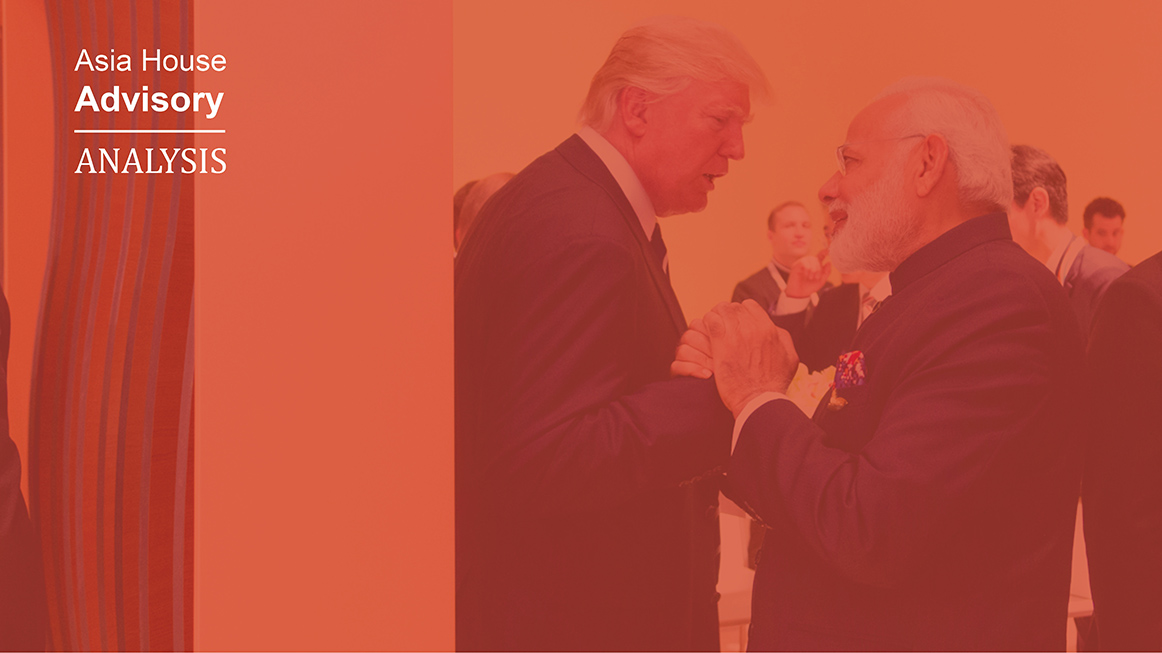Driving commercial and political engagement between Asia, the Middle East and Europe
Driving commercial and political engagement between Asia, the Middle East and Europe
Driving commercial and political engagement between Asia, the Middle East and Europe

Asia House Advisory assesses the prospects for a comprehensive US-India trade agreement.
On 25 February, US President Donald Trump concluded his two-day maiden state visit to India amid high expectations of a US-India trade deal. However, despite 18 months of behind-the scenes-negotiations to resolve trade differences, and President Trump saying that the relationship with India “has never been as good as it is right now,” no long-term agreement was signed during the visit.
There were, though, tentative steps taken towards an interim free trade agreement, which signal a political will to forge closer cooperation and maintain forward momentum on bilateral trade. In a White House statement, released on 26 February, Trump and Indian Prime Minister Narendra Modi “agreed to promptly conclude the ongoing negotiations, which they hope can become phase one of a comprehensive bilateral trade agreement.”
Speaking during his visit, Trump said “the relationship has never been better between India and the United States.” Along with the US-India strategic partnership – driven by the two countries’ interest in balancing China’s economic and military power – the trade relationship has grown in importance for both parties. This has been particularly evident in the past three years.
The US-India bilateral goods and service trade – dominated by the former – has grown from just US$19 billion in 1999 to US$142 billion in 2018. In 2019, the US surpassed China to become India’s largest trading partner. Meanwhile, India is the US’s eighth-largest partner in terms of total trade in goods.
In 2018-19, the US imported US$52.4 billion worth of Indian goods and services, including information technology services, agricultural products and engineering goods. The US exports to India – including diamonds, mineral fuels and aircraft – stood at US$35.5 billion for the same period. According to Trump, since becoming a President in 2017, US exports to India have gone up nearly 60 per cent.
In the past three years, India’s defence and energy purchases have been driving the export growth for the US. This is likely to continue as India focuses on modernising its military and seeks to meet its growing energy needs.
Ahead of Trump’s visit, India finalised two large-scale defence deals with the US, worth more than US$3.5 billion for 30 heavy-duty Navy and Army helicopters. The deals are expected to raise the total value of Indian defence contracts with the US since 2007 to more than US$20 billion. Nearly half of this has been secured in the past three years, following the signing of a breakthrough military agreement in late-2018 allowing sales of high-tech military equipment. On 24 February, American Exxon Mobile also signed an agreement to create infrastructure to expand liquefied natural gas (LNG) access in India and ship LNG to the country.
Despite overall trade growth, India’s high tariffs and the US’s decision to terminate the benefits of low or zero duty to US$5.7 billion Indian exports under the Generalised System of Preferences (GSP) in June 2019, have caused friction. Other contentious issues are intellectual property rights (IPR) regarding patents and copyrights and India’s regulation of state-owned enterprises. The US is also concerned about India’s data localisation regulations.
It is a US preference to sign comprehensive agreements with its trade partners. The agreements typically cover all aspects of trade, from trade in goods and services to IPR and investment. Notwithstanding, Trump seems keen to secure at least a limited deal with India in 2020. In order to do so, the focus is likely to be on the least controversial issues, namely trade in goods and market access, which will also bring some immediate benefits for both countries’ domestic industries.
Securing better market access for both countries’ agricultural products is a mutual priority. US dairy products and Indian food products, including pomegranates, could be included in the agreement. Securing a deal that can bringing down the US$25.3 billion trade deficit with India is a key issue for Trump. This is the case not least because China’s scheduled agricultural purchases under the US-China ‘Phase One’ deal (signed in January 2020) are likely to be delayed, partly due to the Covid-19 outbreak. Securing another positive trade deal for US businesses would be a welcome news for Trump as he is preparing to highlight his government’s achievements ahead of the November presidential election.
Conversely, for Modi, the top priority is restoring the low or zero duty benefits of the US GSP scheme at least for some of the sectors. The GSP covers approximately 2,000 products, from auto components to textiles. While only a small percentage of the overall US$52.4 billion Indian exports to the US was covered under the GSP scheme in 2018-19, some exporters have seen their exports fall significantly following the end of the GSP benefits. Textiles and leather footwear industries have been particularly affected.
The third issue on the agenda is India’s demand for better manpower movement and securing more US visas for Indian software professionals, accountants and nurses.
A limited US-India FTA covering goods and market access is a feasible option for 2020. While Trump this week hinted at immediate launch of the FTA negotiations with India, a formal notification to the Congress and the start of the mandated 90-day notice period will be the main indicator that the trade agreement is moving on. A more comprehensive agreement – encompassing services, IPR and investment – promises the biggest benefit for the growing US-India trade relationship. However, in the short term, a limited deal will be useful to build confidence and keep the positive momentum in bilateral relations.
This analysis was produced by Asia House Advisory, which helps organisations meet business-critical challenges through a range of bespoke services. To find out more about Asia House Advisory and how it can help you, please email advisory@asiahouse.co.uk
